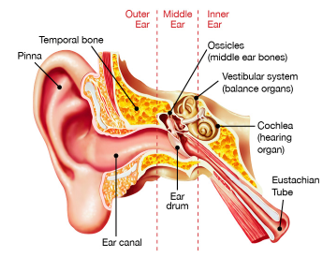Benign Paroxysmal Positional Vertigo (BPPV) is a common disorder of the inner ear with symptoms including dizziness, vertigo, unsteadiness and nausea.
BPPV is the most common cause of vertigo, especially in the older population (people over 65 years old).
BPPV occurs when crystals (called otoconia), normally located in one part of the vestibular (or balance) system of your inner ear (the utricle), become dislodged and collect in another part of the inner ear balance system (one of the semi-circular canals).

As your head moves, the dislodged crystals also move and incorrect messages are sent to your brain and then to your eyes. The brain receives the messages that the head is moving although the head has only moved position slightly. This will cause symptoms such as an illusion of movement or spinning with common movements or changes in position such as rolling over in bed, getting in/out of bed, or looking or reaching up (for example to the top shelf or to put drops into your eye).
Symptoms are usually intermittent but may become recurrent – they can stop for several weeks or months at a time and then return.
What causes BPPV?
The reason the crystals become dislodged is often unknown, although some known causes of BPPV include head injury, degeneration of the vestibular system in the inner ear associated with increasing age, or damage caused by an inner ear disorder. There is also an association between BPPV and osteoporosis, osteopaenia or low Vitamin D levels.
How is a diagnosis made?
Diagnosis of the condition will be based on the following:
- your medical history
- answers to questions about when and where the dizziness occurs
- a physical examination
- the results of any tests carried out by a health professional
Other tests may be required in cases where symptoms do not fit the usual pattern or are in both ears, both of which make diagnosis more challenging.
How is BPPV treated?
BPPV can be diagnosed and is usually effectively treated with simple exercises or manoeuvres, taught by a health professional who is familiar with the techniques required. However, if symptoms persist, you may be referred to a specialist.
BBPV is usually treated using a range of positional manoeuvres that aim to move the crystals out of the semi-circular canal of the inner ear to an area that will not stimulate the wrong messages to be sent by the balance system. Sometimes a second treatment may be necessary. Your health professional can perform these manoeuvres in their rooms or they may give you exercises to perform at home.
If manoeuvres and exercises have been recommended, it is important to persist with the treatment because they provide a simple and non-invasive way to treat the vertigo and nausea associated with BPPV.
BPPV can subside with time, but it is important to seek treatment in the early stages to prevent falls or injury. This is particularly important for the older population when additional balance exercises may also be useful. In extreme cases, surgery can be carried out to block the affected canal without disturbing the function of the rest of the vestibular system.
Very short-term use of motion sickness medications is sometimes useful to control the nausea associated with BPPV.
Gandel Philanthropy Balance Disorders Diagnostics
Through funding from a Gandel Philanthropy Community Grant, the Balance Disorders and Ataxia Service (BDAS) at the Eye and Ear Hospital is the only location in Victoria to have the Epley Omniax Positioning System. The system is used to diagnose and treat BPPV and other forms of dizziness that are brought on when a person moves. A referral to the Balance Disorders and Ataxia Service is required.
Further information
Balance Disorders and Ataxia Service (BDAS) / Neuro-otology Investigation Unit.
The Royal Victorian Eye and Ear Hospital
Ph: (03) 9929 8270
www.eyeandear.org.au/balance
References
Helminksy, Zee, Janssen and Hain (2010). Effectiveness of particle repositioning manoeuvres in the treatment of BPPV: a systematic review. Physical Therapy, 90 (5): 663-678

